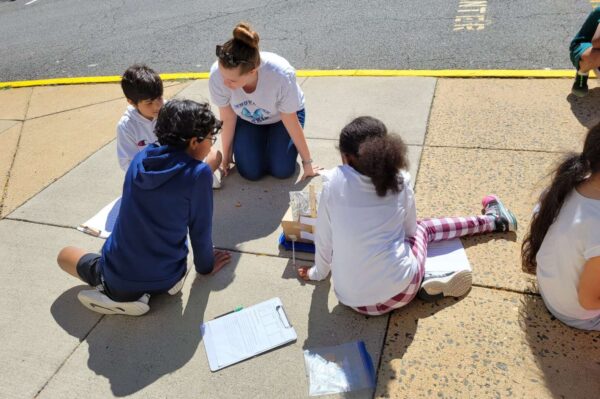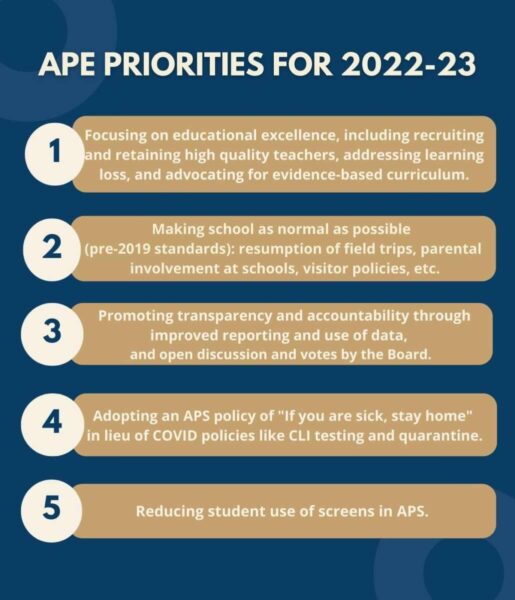
A few hundred parents say Arlington Public Schools should prioritize recreating pre-Covid normalcy in the classroom and evaluating the use of electronic devices.
That’s according to a recent informal survey conducted by Arlington Parents for Education, a parent group that began during the pandemic to advocate for reopening schools.
Since schools reopened, APE has evolved into a School Board watchdog group, with priorities such as reversing pandemic-era learning loss. The group says the survey will inform what APE should advocate for, in addition to ending Covid protocols. The priorities don’t surprise School Board candidates and other education advocacy groups, but some groups say the survey does not speak for the parents they represent.
The survey netted a few hundred responses, about 70% of which reside in North Arlington and a little under 30% in South Arlington, with some respondents living outside the county. Most have elementary-aged children, followed by children in middle and high school. Some also indicated they had children in area private schools, which saw an influx in public school families when they returned for in-person school before APS.
“We recently surveyed hundreds of our parents to see how their students are doing in a post-pandemic world at APS and what they want APS and APE to focus on,” APE said in a statement. “Overwhelmingly, parents want a return to normalcy for their students — full resumption of field trips, in-person orientations, back-to-school events and other parental involvement opportunities in all APS buildings.”
“This also means returning to the pre-pandemic golden rule applicable to any illness: if you’re sick, stay home,” the group added.
APS is, in fact, returning to pre-Covid procedures for field trips and events, APS spokesman Frank Bellavia said.
Masks became optional as of March 1, but students, visitors and teachers have some Covid protocols to follow.
Those with Covid-like symptoms must present a negative test or alternative diagnosis from a medical provider or isolate at home for five days before returning to class. Meanwhile, volunteers, like APS employees, must have proof of vaccination or undergo weekly testing to volunteer, Bellavia said.
For APE, that’s not normal. But for Smart Restart APS, a parent group that started to push for protocols such as outdoor lunch and improved ventilation, said there is no return to life pre-2020.
“Smart Restart APS believes we are living in a new reality, and APS should continue to have appropriate, common-sense measures to adapt to living in this new reality, one which includes the ever-present possibility of COVID-19 infection spreading through our schools,” the group said in a statement. “We have to adapt — not ignore — the new situation.”
The spread of Covid still impacts families, whether a parent misses work or a child brings home Covid to a high-risk family member, the group continued.
“Everyone has a right to access a safe and healthy school environment,” the Smart Restart statement said. “COVID-19 in the air should not be a part of that.”
Moving beyond Covid
Generally, respondents to the APE survey strongly agreed that APS should prioritize student-facing positions over administrative ones and do more to reverse pandemic-induced learning loss.
APS has said these priorities are funded in its 2022-23 school budget. The budget commits to reducing class sizes at the elementary and high school level, paying for a year of tutoring and hiring more staff, including middle school and special education teachers, psychologists and social workers and math coaches.
The survey also found more than 70% of respondents support reducing the use of iPads.
“The screen time issue is multifaceted, but the overarching concern is that there is too much screen time in school particularly for our youngest learners,” APE said. “APS-issued devices are now integral to instruction at every level, yet APS lacks standards for screen time use; does not evaluate of the effectiveness of the iPad or laptop as an instructional tool; does not evaluate or consider the addictive nature of devices; and lastly, APS lacks regulation of the APS-issued and personal devices.”
The pandemic led APS to expand its one-to-one device program, previously only for students in grades 3-12, to include K-2 students. The program is popular with students but has its critics among some parents, a divide that persists today.
Tech concerns ran high two years ago after APS studied device use and found students use digital devices for approximately half of the school day.
APS has since shifted its approach to digital learning, Bellavia said, to take greater consideration of when to use devices.
Minutes spent in front of a screen appear to have dropped as well, per a report from February 2022 analyzing device use between September and November 2021. Elementary and middle schoolers used a math instruction program for an average of 4.5-6 minutes per school day, for instance, while middle school students used a literacy program for about 2.5-3 minutes per day.
Some experts recommend no more than two hours of screen time per day, except for homework, for five to 17-year-olds.
School Board candidate Vell Rives, a psychiatrist, is also concerned about tech use.
“Kids are on screens too much on their own, outside of APS control, but APS’s heavy reliance on screens compounds the problem,” he said.
As for the rest of the survey, he said “those are all accurate reflections of what I’m hearing as I talk to voters.”
Equity
School Board candidate Bethany Sutton, who has the endorsement of the Arlington County Democratic Committee, said APS already is focused on the issues described in the survey.
But, she said, the survey is missing the concern many parents share about the historically lower academic outcomes for children of color.
“The wider range of parent and community perspectives, beyond the APE group, also includes a sense of urgency around issues of equity in student outcomes, even as we seek to make sure that all students receive an excellent education in Arlington,” she said. “And ensuring safety and a sense of belonging at school are paramount to having emotionally healthy students ready to learn.”
It did not surprise Symone Walker — the chair of the Arlington branch of the NAACP’s education committee, as well as a former School Board candidate and opinion columnist — that improving academic outcomes for Black and Hispanic students was not one of the top 5 advocacy priorities identified by APE from survey responses.

“I understand that to an extent. Just like my advocacy for literacy and equitable access to education was driven by my experience with the reading struggles of my child and inequitable access to special education resources and interventions experienced by many Black families,” she said. “It is reflective of their constituency and the concerns they have, which clearly aren’t the historic and pervasive achievement gaps of Black children.”
Walker acknowledged the group does discuss the issue of equity, but said that it is brought up when it aligns with other priorities.
“While they contend that addressing learning loss is an ‘equity’ issue for Black and Brown students, which nobody disputes, the equity issue for APE is merely an overlapping concern,” Walker said.

